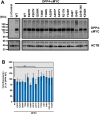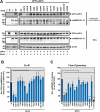Polymorphisms in dipeptidyl peptidase 4 reduce host cell entry of Middle East respiratory syndrome coronavirus
- PMID: 31964246
- PMCID: PMC7006675
- DOI: 10.1080/22221751.2020.1713705
Polymorphisms in dipeptidyl peptidase 4 reduce host cell entry of Middle East respiratory syndrome coronavirus
Abstract
Middle East respiratory syndrome (MERS) coronavirus (MERS-CoV) causes a severe respiratory disease in humans. The MERS-CoV spike (S) glycoprotein mediates viral entry into target cells. For this, MERS-CoV S engages the host cell protein dipeptidyl peptidase 4 (DPP4, CD26) and the interface between MERS-CoV S and DPP4 has been resolved on the atomic level. Here, we asked whether naturally-occurring polymorphisms in DPP4, that alter amino acid residues required for MERS-CoV S binding, influence cellular entry of MERS-CoV. By screening of public databases, we identified fourteen such polymorphisms. Introduction of the respective mutations into DPP4 revealed that all except one (Δ346-348) were compatible with robust DPP4 expression. Four polymorphisms (K267E, K267N, A291P and Δ346-348) strongly reduced binding of MERS-CoV S to DPP4 and S protein-driven host cell entry, as determined using soluble S protein and S protein bearing rhabdoviral vectors, respectively. Two polymorphisms (K267E and A291P) were analyzed in the context of authentic MERS-CoV and were found to attenuate viral replication. Collectively, we identified naturally-occurring polymorphisms in DPP4 that negatively impact cellular entry of MERS-CoV and might thus modulate MERS development in infected patients.
Keywords: Middle East respiratory syndrome coronavirus; dipeptidyl peptidase 4; polymorphisms; receptor binding; spike glycoprotein.
Conflict of interest statement
No potential conflict of interest was reported by the authors.
Figures






References
-
- WHO . MERS situation update http://www.emro.who.int/health-topics/mers-cov/mers-outbreaks.html2019 [updated 2019–05]. Available from: https://www.who.int/emergencies/mers-cov/en/.
MeSH terms
Substances
LinkOut - more resources
Full Text Sources
Other Literature Sources
Medical
Miscellaneous
